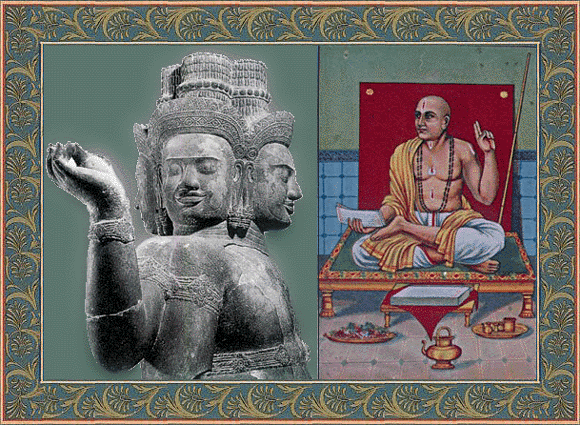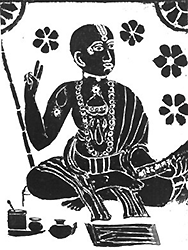

"Brahma is mahajana. Or there are twelve, twelve mahajanas stated in the sastras, and Brahma is one of them. Svayambhu. Brahma's name is Svayambhu. The other day we were discussing Svayambhu. Or Atmabhu. Atmabhu. Because he is born out of the abdomen of the father, not of the mother. ...Father is the seed-giving, life-giving agent. So this life was not transferred to anyone else to take the body. The life-giver, father, gave him the body. Therefore Brahma is called Svayambhu."
Srila Prabhupada Lecture on Srimad-Bhagavatam, 10-21-74, Mayapur
"Thus Brahma was initiated by the Krsna mantra, by Lord Krsna Himself, and thus he became a Vaisnava, or a devotee of the Lord, before he was able to construct the huge universe. It is stated in the Brahma-samhita that Lord Brahma was initiated into the eighteen-letter Krsna mantra, which is generally accepted by all the devotees of Lord Krsna. We follow the same principle because we belong to the Brahma sampradaya, directly in the disciplic chain from Brahma to Narada, from Narada to Vyasa, from Vyasa to Madhva Muni, from Madhva Muni to Madhavendra Puri, from Madhavendra Puri to Isvara Puri, from Isvara Puri to Lord Caitanya and gradually to His Divine Grace Bhaktisiddhanta Sarasvati, our divine master."
Srimad-Bhagavatam 2:9:6
"Brahma is the direct recipient of Vedic knowledge from the Personality of Godhead, and anyone discharging his entrusted duties in disciplic succession from Brahma is sure to gain fame in this life and salvation in the next. The disciplic succession from Brahma is called the Brahma-sampradaya, and it descends as follows: Brahma, Narada, Vyasa, Madhva Muni (Purnaprajna), Padmanabha, Nrhari, Madhava, Aksobhya, Jayatirtha, Jnanasindhu, Dayanidhi, Vidyanidhi, Rajendra, Jayadharma, Purusottama, Brahmanyatirtha, Vyasatirtha, Laksmipati, Madhavendra Puri, Isvara Puri, Sri Caitanya Mahaprabhu, Svarupa Damodara and Sri Rupa Gosvami and others, Sri Raghunatha dasa Gosvami, Krsnadasa Gosvami, Narottama dasa Thakura, Visvanatha Cakravarti, Jagannatha dasa Babaji, Bhaktivinoda Thakura, Gaurakisora dasa Babaji, Srimad Bhaktisiddhanta Sarasvati, A. C. Bhaktivedanta Swami."
This line of disciplic succession from Brahma is spiritual, whereas the genealogical succession from Manu is material, but both are on the progressive march towards the same goal of Krsna consciousness."
Srimad-Bhagavatam 3:13:8
"All the four Sampradayas ... are after worshipping the Supreme Lord Visnu, in His different Expansions, and some of them are in favor of worshipping Radha Krishna."
Srila Prabhupada Letter to Upendra, 02-13-68
"Out of the four sampradayas, the Sri Madhvacarya-sampradaya was accepted by Madhavendra Puri. Thus he took sannyasa according to parampara, the disciplic succession. Beginning from Madhvacarya down to the spiritual master of Madhavendra Puri, the acarya named Laksmipati, there was no realization of devotional service in conjugal love. Sri Madhavendra Puri introduced the conception of conjugal love for the first time in the Madhvacarya-sampradaya, and this conclusion of the Madhvacarya-sampradaya was revealed by Sri Caitanya Mahaprabhu when He toured southern India and met the Tattvavadis, who supposedly belonged to the Madhvacarya-sampradaya."
Caitanya-caritamrta, Madyam lila 4:197
 "Perhaps you know the picture of Madhvacarya, one of the great Acaryas in our line, who is holding two fingers up to indicate Krishna and jiva. The impersonalists hold up one finger because their idea is that everything is one. So if we make the Spiritual Master identical with Krishna, then we will also become impersonalists. If we say that our Spiritual Master is Krishna, then the conclusion is that if we become Spiritual Master some day, then we will also become Krishna. Please try to understand how dangerous this kind of reasoning is.
"Perhaps you know the picture of Madhvacarya, one of the great Acaryas in our line, who is holding two fingers up to indicate Krishna and jiva. The impersonalists hold up one finger because their idea is that everything is one. So if we make the Spiritual Master identical with Krishna, then we will also become impersonalists. If we say that our Spiritual Master is Krishna, then the conclusion is that if we become Spiritual Master some day, then we will also become Krishna. Please try to understand how dangerous this kind of reasoning is.
In my books I have tried to explain clearly this simultaneously one and different philosophy acinta beda beda tattva propounded by Lord Caitanya Mahaprabhu. But sometimes it happens that this philosophy is given a self-interested interpretation. As soon as personal motivation comes in it is not possible for one to understand our Krishna Consciousness philosophy."
Srila Prabhupada Letter to Isana and Vibhavati, 09-21-70
Each of the bonafide sampradaya has its own distinct commentaries on Vedanta. Sri Madhvacarya's Purnaprajna-bhasya establishes suddha-dvaita-vada, or purified dualism. While the Mayavadi scholars do not accept the Puranas, Srila Madhvacarya and all other authorities accept them as the authoritative histories of the world. The Puranas are not chronologically recorded, but the incidents mentioned in the Puranas are actual histories of bygone ages. Srimad-Bhagavatam is the Maha-purana, the essence of all the Puranas.
The Brahma Sampradaya is divided into two schools: the Gaudiya Vaisnavas and the Tattva-vadi Madhavas (the Dvaitas). Of the Dvaita school, the Haridasa movement is prominent. The founding acarya of the Haridasa was Sri Narahari Tiirtha, a direct disciple of Madhavacarya, who preached a simplified version of Madhava's tattva. The Haridasa's worship Vittala and other manifestations of Lord Krishna.
"Sri Caitanya Mahaprabhu accepted the chain of disciplic succession from Madhva Acarya, but the Vaisnavas in His line do not accept the tattva-vadis, who also claim to belong to the Madhva-sampradaya. To distinguish themselves clearly from the tattva-vadi branch of Madhva's descendants, the Vaisnavas of Bengal prefer to call themselves Gaudiya Vaisnavas. Sri Madhva Acarya is also known as Sri Gaudapurnananda, and therefore the name Madhva-Gaudiya-sampradaya is quite suitable for the disciplic succession of the Gaudiya Vaisnavas. Our spiritual master, Om Visnupada Srimad Bhaktisiddhanta Sarasvati Gosvami Maharaja, accepted initiation in the Madhva-Gaudiya-sampradaya."
Caitanya-caritamrta, Adi lila 1:19
"This philosophical truth of simultaneous oneness and difference was propounded by Lord Sri Caitanya Mahaprabhu, and it is known as acintya-bhedabheda-tattva. Brahma, Narada and all others are simultaneously one with the Lord and different from the Supreme Lord. We are all one with Him, just as the gold ornaments are one in quality with the stock gold, but the individual gold ornament is never equal in quantity with the stock gold. The stock gold is never exhausted even if there are innumerable ornaments emanating from the stock because the stock is purnam, complete; even if purnam is deducted from the purnam, still the supreme purnam remains the same purnam. This fact is inconceivable to our present imperfect senses. Lord Caitanya therefore defined His theory of philosophy as acintya (inconceivable), and as confirmed in the Bhagavad-gita as well as in the Bhagavatam, Lord Caitanya's theory of acintya-bhedabheda-tattva is the perfect philosophy of the Absolute Truth."
Srimad-Bhagavatam 2:6:13-16
![[BVML Home Page]](../../grfx/bml_logo.gif)
